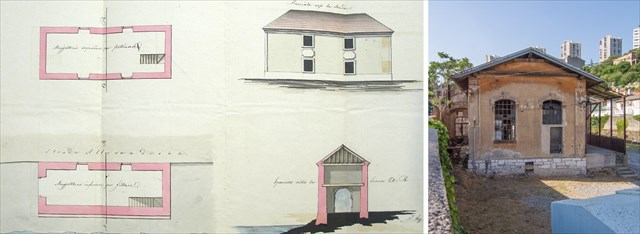
Godine 1764.Nicolò Crespi, podrijetlom iz Riminija, otvara u Rijeci manufakturukonopa. Osnovni proizvod tvornice bio je konop za brodove. Iz izvora je vidljivo da je 1802. godine tvornica imala šesnaest zaposlenih. Modernizaciji tvornice uvelike je pridonio Giovanni Sirola koji postaje vlasnik tvornice oko 1860. godine. Sirola je zamislio preseljenje manufakturne proizvodnje u novu veću građevinu, za čiji je projekt zadužio Emilija Ambrosinija 1901. godine. Riječ je o jednostavnoj građevini pravokutna oblika s naglašenim centralnim prostorom gdje je bila smještena sala za predionicu konopa. Objekt je raščlanjen nizom velikih prozorskih otvora s blagim polukružnim lukom. Dekoracija kojom se Ambrosini ovdje izražava upućuje na skromne, ali uočljive secesijske elemente. Zgrada je danas u raspadnutom stanju, bez krovišta. To je sve što je ostalo sačuvano od nekadašnje Riječke tvornice konopa. Početkom 20. stoljeća tvornica je izrađivala konope za austrougarsku flotu u Puli, za riječku Tvornicu torpeda i za Brodogradilište 3. maj. Tijekom Prvoga svjetskog rata tvornica doživljava krizu iz koje teško izlazi, da bi ju nova kriza zaskočila neposredno nakon Drugoga svjetskog rata. U poduzeću se počinju izmjenjivati vlasnici, a 80-ih godina cjelokupna proizvodnja seli na Škurinje. Cijelo je postrojenje razrušeno pri izgradnji trgovačkih centara.
RI EPK 2020.
RIJEKA KROZ POVIJEST
ŠTO POSJETITI?
qRIJEKA


In 1764, Nicolò Crespi, a native of Rimini, opened a manufacturing plant for ropes in Rijeka. The company’s main products were ropes for ships. Sources show that the plant had sixteen employees in 1802. Giovanni Sirola, who gained ownership of the factory around 1860, greatly contributed to the modernization of the factory. Sirola gave the idea of moving the manufacturing production to a new, larger building and, in 1901, he put Emilio Ambrosini in charge of the project. It is a simple rectangular building with a prominent central area where the rope spinning section was located. The integrity of the facility is split by a series of large windows with a mild semi-circular arch. The decorations used by Ambrosini indicate very modest but noticeable Art Nouveau elements. The building is now in a degraded state with no roof. It represents everything that was preserved from the former Rope Factory of Rijeka. At the beginning of the 20th century, the factory manufactured ropes for the Austro-Hungarian fleet in Pula, Rijeka’s Torpedo Factory and the Shipyard 3. Maj. During the World War I, the factory experienced a crisis from which it struggled to come out, only to enter a new crisis immediately after World War II. The company’s owners started rotating and, in the 1880s, the entire production was moved to Škurinje. The entire plant was destroyed during the construction of shopping centres.
RIJEKA ECoC 2020
RIJEKA THROUGH HISTORY
WHAT TO SEE?
qRIJEKA
